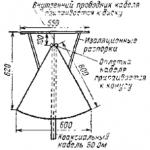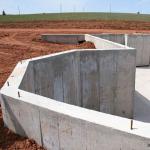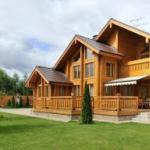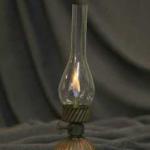Using the attic instead of a full-fledged second floor allows you to rationally use the available space and significantly expand the living space. There are many options for attics; the most popular of them is a sloping roof, which is not only aesthetically attractive, but also financially beneficial. If you wish, you can build such an attic with your own hands.
Users often search:
What parts does a broken attic consist of?
The first stage of roof construction is design and calculation; regardless of whether the project is ordered in a special organization or it is planned to make a design drawing on its own, first of all it is necessary to figure out what main parts the broken attic consists of.

In essence, a sloping roof is a residential attic, well enough insulated and protected from moisture and noise to make it comfortable to live in. Therefore, in terms of design, it differs slightly from an ordinary gable roof.
The following main elements of a sloping roof are distinguished:
- vertical racks;
- puffs - horizontal beams;
- rafters - stiffeners, which are the skeleton of the entire structure;
- struts - diagonal beams supporting the rafters;
- Mauerlat - wooden beams with special fasteners connecting the structure with the walls of the house;
- ridge run- set of upper elements truss system;
- grandmas - fasteners that ensure the rigidity of the hanging rafters;
- contractions - horizontal struts that remove part of the load from the rafters;
- crate - a frame for fastening roofing material and insulation;
- roofing - can be made of ceramic tiles, different types slate, profiled sheet and many other materials;
- heat, hydro and sound insulation.
Thus, the whole structure consists of a set right triangles. They are connected to each other with wooden beams. All the elements described are easy to find on the drawing of a broken attic.

Technical requirements for sloping roof
Sloped roofs are subject to the following requirements:
- the height of the attic walls must exceed 2.2 m;
- should be provided good ventilation so that moisture does not condense under the roof;
- roofing material should have a small mass;
- the design must provide for measures against the impact of additional load on the truss system - that is, the roof elements must withstand not only their own weight, but also, for example, snow;
- the attic loses heat faster than the lower floors, so thermal insulation must be given Special attention;
- to provide fire safety all wooden beams and batten elements should be treated with flame retardants.
Varieties of truss systems
The device of a sloping roof is very simple - its slope, as it were, breaks into lower and upper parts, each of which is set at its own angle. Most often they are mounted at an angle of 60–70 °, and 15–30 °, respectively.
Based design features attic can be distinguished such types of mansard sloping roofs.
- Two types of rafters are used: hanging and layered. The attic floor beams are installed, a little short of the edges of the walls of the lower floor. The lower slope is made of layered rafters, which are attached to the walls of the house with the help of a Mauerlat. The frame of the attic walls is made from the racks. Such triangles are installed along the walls and connected by contractions. From above, they are joined by triangles of hanging rafters, based on a puff.
- To increase the area of \u200b\u200bthe room, the lower edges of the rafters can be brought outside the house. In this case, they will not be attached to the Mauerlat, but to the ceiling, which, in turn, is held on external walls oh at home with the help of Mauerlat. The rafters are necessarily supported by struts. Racks go deep into the floor beams by no more than a third of their thickness.
- This sloping roof truss system is different in that the upper triangles are made from layered, not hanging rafters. In this case, the puffs are supports for the uprights of the upper triangles.

Sloped roof calculation
Before starting work, two calculations must be carried out:
- determination of the amount of necessary building materials;
- calculation of the bearing capacity of the structure.
Determining how much material is needed is very simple due to the simple geometry of the sloping roof. Bearing capacity is not so easy to deal with. For its calculation it is necessary to take into account:
- weight of the roof;
- approximate mass of snow;
- the mass of the crate;
- mass of steam, hydro and heat insulating materials;
- roof dimensions;
- installation angles of slopes;
- the installation step of the elements of the truss system and roofing sheathing;
- additional load: mass of people and equipment, windows, ventilation, etc.
Based on these data and with the help of special programs, the bearing capacity is calculated. Depending on what bearing capacity is required, the cross-sectional area used in construction is selected. wooden beam. If something does not suit you, the project can be corrected by changing the truss system, choosing a different roofing material, placing the rafters less often.
In most programs, the design of a sloping roof can be visualized - it will be immediately visible on the 3D model how the changes will affect the appearance of the attic.

What materials need to be prepared?
After the development of the project, it will be clear which beam with which section should be used, which roofing material is better to choose, what should be the roof lathing. Will have to purchase big variety lumber: timber for the formation of Mauerlat, edged boards for the truss system, boards for battens. They need to be properly selected so that the design is durable and reliable.
Tips for choosing lumber:
- coniferous woods - pine, spruce - are best suited for building an attic - they are strong and rigid enough to withstand the entire load;
- wood should be well dried - its moisture content should not exceed 20%;
- the material must be free of knots, cracks, traces of biological damage and other defects.
Before installation, all wood is treated with flame retardants and antiseptics, as well as impregnations from decay. This treatment should be repeated periodically so that it is not necessary to replace load-bearing elements designs.
In addition to the main material, you need to stock up on metal fasteners for connecting the rafters to the Mauerlat and to each other, insulating and roofing materials.
Roof installation

Mauerlat installation
The construction of a sloping roof begins with the installation of a Mauerlat, to which the ends of the rafters will be attached. The nuances of this stage vary depending on the material from which the lower floor is built - if its walls are stone, you need to punch holes for anchors in them in advance and install fasteners. The spacing between anchors should not exceed 2 m.

Placed on the surface of the wall waterproofing material. Then the beam is marked, holes are drilled at the points of installation of the fasteners. Mauerlat is put on the anchor and tightly attracted with nuts.
Installation of floor beams
Installation sequence:
- first, extreme beams are placed from the ends of the building;
- strings are stretched between them to indicate the plane;
- intermediate beams are installed.
Mounting racks
Racks must be set strictly vertically. The principle of operation is the same as in the case of floor beams - first, the extreme racks are mounted, then the intermediate ones in the same plane. The step between the structural elements should not exceed 2 m. The racks are fixed with temporary struts. The height of the beams is 10 cm more than the planned height of the ceilings.
Runs from edged board. The result should be a finished frame for internal walls attic.
Installing puffs
The transverse beams are connected not to the racks, but to the girders, using metal roofing corners. If the width of the room is large, it is worth installing temporary spacers under each puff so that when walking on them during the construction of the upper slopes, the beams do not break or sag.
Rafter installation
First, the lower rafters are mounted. They are placed in the following order:
- mounting points are planned on the Mauerlat - the step between them should be 1–1.2 m;
- on rafter legs ah, the attachment points are cut according to the template;
- first, the extreme rafters are attached, then, as before, intermediate ones along the twine;
- struts are installed in accordance with the drawing.
The upper rafters are placed in the same way - according to the template. They are attached to puffs and interconnected; a longitudinal connection with a ridge beam is required only if the length of the attic exceeds 10 m. Otherwise, struts can be dispensed with, with which the construction of a broken mansard roof will be quite rigid.

The last stages of work are the sheathing of the gables and the fastening of the lathing for the roof. Window openings should be left in the gables (at least 1/8 of the total area of the outer walls of the attic).
Structural insulation
On the finished frame, it remains only to lay the roofing cake. Its first layer is a vapor barrier, which prevents moisture from penetrating into the insulation. A heat-insulating material is laid on the vapor barrier membrane - it is recommended to use stone basalt slabs. They are laid in several layers with a shift in the joints, which will protect against the occurrence of cold bridges. The size of the plates should be several cm more step between the beams of the counter-lattice. So that the insulation does not sag and does not lose its performance characteristics, its density must be at least 35 kg / m 3.

From above, the insulation is covered with a waterproof membrane, which allows steam to pass through, but does not allow liquid moisture to penetrate into the room. A roof is laid on top of the waterproofing layer - the features of its installation depend on the selected material.
After the installation of the roof, only the finishing touches will remain - the installation of drainage systems, decorative trim. Inside, the finishing material is also attached to the crate over the thermal insulation. Sloping roof built. As you can see, it is quite possible to do it yourself - only the design and calculation will probably have to be entrusted to professionals.
A sloping or mansard roof is one of the most popular and common types of roofing. It is particularly efficient and convenient in the case when the attic involves the arrangement of a living room. The fracture of the slopes gives a significant extra space, while the upper level acts as a roof, and the lower one becomes the walls for the room.
A house with a sloping roof is quite common in our country. Similar type roofing is widely used both in covering private houses and in cottage construction. Frame house often happens with a sloping roof. This is due to the fact that frame structure does not involve the construction of a large house, and the attic roof helps to make the most of the space on the second floor to create another living room in a country house.
A broken roof is quite simple to build, although it requires special calculations in its design. With some experience, you can build it yourself. In the article we will look at how to build a sloping roof with our own hands.
In this article
Design
A sloping roof requires a preliminary calculation of all elements. The design is carried out in two stages:

The truss system of a house with a sloping roof is calculated adjusted for weight finish coat. Calculation required amount roofing is made by calculating the area of the roof. This roof represents four planes in the form of rectangles, its area will be equal to the sum of their areas.
It is important not to forget to add 15% to the resulting number to form the joints of the roofing material and unforeseen situations.
Having calculated the area of the roofing material, it is easy to find out its weight and, in accordance with this, design a rafter system as capable of holding this roofing material. In addition to the weight of the roof itself, when designing the rafter system, it is necessary to take into account:
- A lot of other elements roofing cake: insulation, insulating materials, battens;
- The length of the rafter legs, the step of the truss system and the batten;
- The slope of the roof slopes, the height of the ridge;
- Temporary loads on the roof, such as the weight of builders, skylights (if they are planned), various fences and junctions.

The choice of the slope angle of the roof slopes is one of the important design points, which is based on a number of factors:
- Type of roofing;
- Wind load and precipitation intensity of a particular region.
The classic angles of inclination of the slopes of a broken roof are located within 35-45 ° for the upper tier and 60 ° for the lower one.
It should be borne in mind that if the under-roof space will be used for a living room, then the height of the ridge cannot be less than 2.5 m.

If you plan to add an extension to a house with a sloping roof, we recommend that this be included in your plan in advance. As a rule, such extensions are covered shed roof, which is, as it were, a continuation of one of the lower slopes of the roof.
If the design of the house involves the presence of a roof with a balcony, then it is advisable to extend roofing so that the balcony is under its slopes and is not exposed to the destructive effects of precipitation.
Material selection
After the completion of the calculation work, you can proceed to the selection of materials for the construction of the roof. Sloping roofs suggest a fairly standard approach to the formation of a roofing cake and choice building materials:
- Mauerlat and girders are made of durable thick bars with a section of 200 * 200 and 50 * 100 mm, respectively;
- Rafter legs are formed from bars 50 * 200 mm;
- To create a counter-lattice and crate, boards of a smaller section of 50 * 50 or 20 * 90 mm will go;
- To create under the roof warm room you will need a 200 mm thick insulation, as well as hydro and vapor barrier materials.
A broken roof and its strength depend not only on the accuracy of the calculations made and the choice of building materials, but also on the quality of the wood. We recommend choosing bars and boards conifers trees with a moisture content of not more than 20-22% without cracks and knots.

Before the beginning installation work All wooden elements V without fail are covered twice with special antiseptic solutions that keep the wood from rotting and pests. A roof constructed from such materials will be strong, solid and will last for decades.
It is important to determine the roofing material before starting installation work, since a number of important features rafter system, such as rafter spacing and battens. The mansard roof is compatible with any type of roof, as it has a fairly simple geometry and does not give a large waste of materials.
Installation
So how do you make a sloping roof? erection mansard roof on its own requires compliance with a number of rules. Let us consider in more detail how to build such a type of roof step by step as a sloping roof with your own hands. 
Installation of Mauerlat and truss system
The mauerlat beam is attached along the top of the walls to specially prepared studs. The optimal step between the studs is approximately 2 meters. Mauerlat bars are additionally attached to the walls with a wire tie. To protect the walls from moisture under the Mauerlat, it is necessary to lay a layer of roofing material.
The next step is to lay the floor beams, which will serve as a frame for uprights rafter system. The bars can be laid on the Mauerlat with fixing with iron corners or in recesses made in advance in the wall masonry.
When laying beams, it is important to maintain a horizontal level.
Installation of the truss system begins with vertical rafters with level control. Further, runs with fastening with iron corners lie on the racks. Parallel racks are fastened together with puffs, which can be reinforced with struts for additional support.

The lower tier of the rafters has a Mauerlat and a run as its support. The rafters are pre-cut at an angle and attached to the support with plates. Strengthening of the lower rafter legs is carried out by struts, the lower edge of which is installed at an angle on the beam, and the upper one is mounted to the rafter with a bolt.
The upper rafters are also pre-cut according to the template. In the upper part, they are connected with boards or plates, and the lower part is inserted into the run with fastening with corners. The rafter legs are additionally reinforced with a stand to the place where the rafters are fastened and tightened.
Insulation, lathing and roofing

After the installation of the truss system, work is carried out on the insulation of the roof. Waterproofing is laid on the rafters from the outside with an overlap of 10-15 cm of rolled material. The material is attached to the rafter legs with nails. Further work is moved under the roof. Layers of mineral wool are laid between the rafters and covered with vapor barrier material. The whole structure is sewn up from the inside with building cardboard under finishing interior space.
Outside, a counter-lattice is stuffed onto the waterproofing layer and then a crate with a step corresponding to the type of roofing material chosen.
The roofing material is laid in accordance with the installation rules for the selected type of roof, but in in general terms repeats the basic rules: laying from the bottom of the slope up.
We figured out how to make a broken roof on our own. By following our instructions, you will get a strong and reliable roof, which long years will delight you with its efficiency and convenience.
A house with an attic is not only an additional living space but also a respectable view of the entire building. Even if the room under the roof is made unheated and is used only in the summer, it still creates a powerful "air cushion" that helps to retain heat inside the entire capital building.
And about, then - read on our portal.
Attic project
When drawing up a scheme for building an attic, it is best to do this in different projections in order to see and understand the placement of all elements of the truss system. It is very important to correctly calculate the height of the roof ridge, since the size of the area under it will directly depend on it.

When drawing up a scheme-project for the construction of a mansard roof, you need to calculate the height of the ridge, the ceiling and the total area of \u200b\u200bthe room.
The minimum height from the floor to the ridge should be 2.5-2.7 m, if this distance is less, then the room is not an attic, it can only be called an attic. This parameter is set by the norms of SNIP.

To ensure that all elements are drawn accurately and have the desired location in common system you need to start from a figure with right angles, that is, a rectangle or square - a section of the created attic space. Based on the sides (height and width of the future room), it will be almost impossible to make a mistake with the angles at which roof slopes are located, with the location of the ridge, rafters and all retaining elements. Determining these parameters, they must immediately be entered into the drawing.
First you need to find the middle of the width of the front wall. Starting from this point, the parameters of the height of the ridge, the future ceiling of the attic, the location of the rack-walls and the size of the cornice overhang are determined.
Due to the fact that each of the structures has a certain number of connecting nodes that have different configurations, it would be nice to draw each of these ligaments separately in order to understand their features of conjugation among themselves of all elements connecting at this point.

Any truss system consists of basic elements and additional ones, which may not be in every design. The main components of the mansard roof are.
- Floor beams, which are the basis for the rest of the elements of the truss system. They are laid on the main walls of the building.
- Rafter leg, straight in gable system roof or consisting of two departments - in broken pattern. In this case, the upper rafter is called the ridge rafter, as it forms the highest point of the roof - and the rafters that form the walls of the attic are called side rafters.
- A ridge board or beam is an indispensable element for a gable roof, but is not always used when constructing a broken roof model.
- Mauerlat - a powerful bar, fixed to the main side walls of the building. Rafter legs are installed on this element.
- Racks are supporting elements necessary to strengthen a gable and broken structure. In the latter case, a ridge and side rafters are attached to it, and in the first case, the stand is a reliable support for a long rafter. In addition, the racks serve as a frame for insulation and sheathing of the attic walls.
- Diagonal braces or bevels additionally hold the posts or stringers and rafters together, making the structure more durable.
- Attic floor beams are used in all attic options - they connect the racks, and they are also the frame for the ceiling device.
- Interrafter runs are installed in a broken form of the roof for structural rigidity.
To be sure that the prepared project is developed correctly, you need to show it to a specialist. Only he can determine whether the attic parameters are correctly selected for the width and length of the walls of the building.
Video: professional mansard roof calculation using special software
Parameters of materials for the construction of a mansard roof
If the graphic project is ready, then, starting from the dimensions marked on it, you can calculate the amount of materials needed to build a mansard roof. Materials must be selected according to their characteristics, which must meet the requirements of fire and environmental safety. For wood, it is necessary to provide special treatment fire retardants, which will reduce the flammability of the material. So, for the construction you will need:
- Boards for rafter legs. Their cross section is selected according to the results of special calculations - this will be discussed in more detail below.
- A beam having a cross section of 100 × 150 or 150 × 200 mm - for floor beams, depending on the selected truss system and the width between the bearing walls, as well as for girders, diagonal legs or valleys - if they are provided for by the design.
- Beam with a section of 100 × 150 mm or 150 × 150 mm for laying Mauerlat.
- For racks, a beam of 100 × 100 or 150 × 150 mm is usually used.
- Unedged board for subflooring and some fasteners.
- Annealed steel wire with a diameter of 3-4 mm - for fastening together some parts.
- Nails, bolts, staples of different sizes, corners various configurations and other fasteners.
- Metal sheet with a thickness of at least 1 mm - for cutting overlays.
- Lumber for battens and counter battens for roofing material - depending on the type of roofing chosen.
- - for thermal insulation of the roof.
- Waterproofing and vapor barrier membranes.
- Roofing material and fasteners for it.
What section are required rafters
Rafters are roofing elements that will perceive the main external loads, therefore, the requirements for their cross section are very special.
The size of the required lumber will depend on many parameters - on the step between the rafter legs, on the length of these legs between the support points, on the snow and wind load that falls on them.
The geometric parameters of the design of the truss system are easy to determine in the drawing. But with the rest of the parameters - you will have to refer to the reference material and carry out some calculations.
Snow load is not the same for different regions of our country. The figure below shows a map on which the entire territory of Russia is divided into zones according to the intensity of the snow load.

There are eight such zones in total (the last, eighth, is more likely to be extreme, and it can not be considered for the construction of a mansard roof).
Now you can accurately determine the snow load, which will depend on the angle of the roof slope. For this, there is the following formula:
S = Sg × μ
Sg- tabular value - see the map and the table attached to it
μ — correction factor depending on the steepness of the roof slope.
- If the slope angle is less 25° then μ=1.0
- With a steepness from 25 to 60 ° - μ=0.7
- If the roof is steeper than 60 °, then it is considered that the snow does not linger on it, and the snow load is not taken into account at all.
It is characteristic that if the mansard roof has broken structure, then for different parts of it, the load can have different values.

The angle of the roof slope can always be determined either by a protractor - according to the drawing, or by a simple ratio of the height and base of the triangle (usually - half the width of the span):
The wind load also mainly depends on the region of construction of the building and on the characteristics of its environment and roof height.

And again, for the calculation, the initial data on the map and the table attached to it are first determined:
The calculation for a particular building will be carried out according to the formula:
Wp = W × k × c
W- tabular value, depending on the region
k- coefficient taking into account the height of the building and its location (see table)
The following zones are indicated in the table with letters:
- zone A - open areas, steppes, forest-steppes, deserts, tundra or forest-tundra, open to the winds of the coast of the seas, large lakes and reservoirs.
- zone B - urban areas, wooded areas, areas with frequent obstacles to the wind, relief or artificial, at least 10 meters high.
- zone IN- dense urban development with an average height of buildings above 25 meters.
With- coefficient depending on the predominant wind direction (wind rose of the region) and on the angle of inclination of the roof slopes.
With this coefficient, the situation is somewhat more complicated, since the wind can have a double effect on the roof slopes. So, it has a direct, overturning effect directly on the roof slopes. But at small angles special meaning takes on the aerodynamic effect of the wind - it tries to raise the plane of the slope due to the emerging lifting forces.

In the drawings, diagrams and tables attached to them, the sections of the roof that are subject to maximum wind loads are indicated, and the corresponding coefficients for calculation are indicated.
It is characteristic that at slope angles up to 30 degrees (and this is quite possible in the section of ridge rafters), the coefficients are indicated both with a plus sign and negative, that is, directed upwards. They somewhat extinguish the frontal wind load (this is taken into account in the calculations), and in order to level the effect of lifting forces, it will be necessary to very carefully fix the truss system and roofing material in this area using additional connections, for example, using annealed steel wire.
After the wind and snow loads are calculated, they can be summed up, and, taking into account the design features of the system being created, determine the cross section of the boards for the rafters.
Please note that the data are given for the most commonly used coniferous material (pine, spruce, cedar or larch). The table shows maximum length rafters between support points, the section of the board depending on the grade of the material, and on the step between the rafters.
The value of the total load is indicated in kPa (Kilopascals). Convert this value to more familiar kilograms by square meter- not difficult. With quite acceptable rounding, you can accept: 1 kPa ≈ 100 kg/m².
The dimensions of the board according to its section are rounded up to standard sizes lumber in a big way.
| rafter section (mm) | Distance between adjacent rafters (mm) | ||||||
|---|---|---|---|---|---|---|---|
| 300 | 600 | 900 | 300 | 600 | 900 | ||
| 1.0 kPa | 1.5 kPa | ||||||
| higher | 40×89 | 3.22 | 2.92 | 2.55 | 2.81 | 2.55 | 2.23 |
| 40×140 | 5.06 | 4.60 | 4.02 | 4.42 | 4.02 | 3.54 | |
| 50×184 | 6.65 | 6.05 | 5.28 | 5.81 | 5.28 | 4.61 | |
| 50×235 | 8.50 | 7.72 | 6.74 | 7.42 | 6.74 | 5.89 | |
| 50×286 | 10.34 | 9.40 | 8.21 | 9.03 | 8.21 | 7.17 | |
| 1 or 2 | 40×89 | 3.11 | 2.83 | 2.47 | 2.72 | 2.47 | 2.16 |
| 40×140 | 4.90 | 4.45 | 3.89 | 4.28 | 3.89 | 3.40 | |
| 50×184 | 6.44 | 5.85 | 5.11 | 5.62 | 5.11 | 4.41 | |
| 50×235 | 8.22 | 7.47 | 6.50 | 7.18 | 6.52 | 5.39 | |
| 50×286 | 10.00 | 9.06 | 7.40 | 8.74 | 7.66 | 6.25 | |
| 3 | 40×89 | 3.06 | 2.78 | 2.31 | 2.67 | 2.39 | 1.95 |
| 40×140 | 4.67 | 4.04 | 3.30 | 3.95 | 3.42 | 2.79 | |
| 50×184 | 5.68 | 4.92 | 4.02 | 4.80 | 4.16 | 3.40 | |
| 50×235 | 6.95 | 6.02 | 4.91 | 5.87 | 5.08 | 4.15 | |
| 50×286 | 8.06 | 6.98 | 6.70 | 6.81 | 5.90 | 4.82 | |
| total snow and wind load | 2.0 kPa | 2.5 kPa | |||||
| higher | 40×89 | 4.02 | 3.65 | 3.19 | 3.73 | 3.39 | 2.96 |
| 40×140 | 5.28 | 4.80 | 4.19 | 4.90 | 4.45 | 3.89 | |
| 50×184 | 6.74 | 6.13 | 5.35 | 6.26 | 5.69 | 4.97 | |
| 50×235 | 8.21 | 7.46 | 6.52 | 7.62 | 6.92 | 5.90 | |
| 50×286 | 2.47 | 2.24 | 1.96 | 2.29 | 2.08 | 1.82 | |
| 1 or 2 | 40×89 | 3.89 | 3.53 | 3.08 | 3.61 | 3.28 | 2.86 |
| 40×140 | 5.11 | 4.64 | 3.89 | 4.74 | 4.31 | 3.52 | |
| 50×184 | 6.52 | 5.82 | 4.75 | 6.06 | 5.27 | 4.30 | |
| 50×235 | 7.80 | 6.76 | 5.52 | 7.06 | 6.11 | 4.99 | |
| 50×286 | 2.43 | 2.11 | 1.72 | 2.21 | 1.91 | 1.56 | |
| 3 | 40×89 | 3.48 | 3.01 | 2.46 | 3.15 | 2.73 | 2.23 |
| 40×140 | 4.23 | 3.67 | 2.99 | 3.83 | 3.32 | 2.71 | |
| 50×184 | 5.18 | 4.48 | 3.66 | 4.68 | 4.06 | 3.31 | |
| 50×235 | 6.01 | 5.20 | 4.25 | 5.43 | 4.71 | 3.84 | |
| 50×286 | 6.52 | 5.82 | 4.75 | 6.06 | 5.27 | 4.30 | |
Tools
Naturally, during work, one cannot do without tools, the list of which includes:
- Electric drill, screwdriver.
- Building level and plumb line, tape measure, square.
- Axe, chisel, chisel, hammer
- Circular saw, jigsaw, hacksaw.
- Carpentry knife.
Installation will be accelerated if the tools for work are of high quality, and the work is carried out with competent mentors, with assistants, carefully and in stages.
Installation steps
It is necessary to strictly observe the sequence of work - only under this condition the design will turn out to be reliable and durable.
Mauerlat mount
The installation of any truss system begins with fixing a powerful supporting structure at the end of the side walls of the structure. timber - Mauerlat on which it will be convenient to install rafter legs. Mauerlat is made from a high-quality bar with a cross section of at least 100 × 150 mm. It must be laid on the roofing material waterproofing laid along the upper end of the wall (regardless of the material).
Due to the Mauerlat, the load will be evenly distributed along the walls and transferred to the foundation of the building.

The Mauerlat is fixed to the wall with metal studs, which are embedded in advance in concrete belt or a crown running along the upper edge of the wall, or anchor bolts with a diameter of 12 mm. They must go deep into the wall by at least 150 — 170 mm. If the Mauerlat is installed on wooden wall, then the bars are attached to it with the help of wooden dowels.
Installation of the truss structure
- Installation of the truss system begins with the installation of floor beams. They can be mounted on the Mauerlat from above if the beams are planned to be taken out of the perimeter of the building and thereby increase the attic area. In this design, the rafter legs are fixed to the floor beams.
 Floor beams fixed on top of the Mauerlat (Fig. A)
Floor beams fixed on top of the Mauerlat (Fig. A) - Otherwise, they may fit into waterproofed walls and fastened with corners or staples to the inner edge of the Mauerlat. This option is used when the rafter legs are planned to be fixed directly to the Mauerlat.
 Another option - only rafter legs are attached to the Mauerlat
Another option - only rafter legs are attached to the Mauerlat - Next, you need to find the middle of the floor beam, since this mark will become a guideline for determining the location of the support posts and the ridge.
- Racks should be located at the same distance from the marked middle of the floor beam. In the future, they will begin to determine the location of the walls of the attic room, that is, its width.
- Bars for racks should have a cross section equal to the size of the floor beams. Construction sites are attached to the beams with the help of special corners and wooden linings. However, to begin with, they are first baited with nails, then carefully leveled with the help of a building level and a plumb line, and only then they are fixed thoroughly, with the expectation of future loads.

- When the first pair of racks is installed, they are fastened together from above with a bar, which is called a puff. This puff is also connected to the racks using special metal corners.

- After fixing the puff, you get a U-shaped design. Layered rafters are installed on it on the sides, which are attached to the floor beam with their second end or are laid on the Mauerlat.
- A special notch (groove) is cut out on the installed supports for the timber or in the rafters. With its use the rafters are tightly installed on the mauerlat beam, and fastened with metal brackets.

- For structural rigidity, struts can be additionally installed from the base of the rack to the middle of the installed side rafter. If this seems not enough, and saving material is not in the foreground, then you can strengthen general design also with additional racks and fights (they are indicated in the drawing in Fig. A with translucent lines).
- Further, the middle is calculated on the puff - a headstock will be attached to this place, supporting the ridge connection of the upper hanging subsystem of the rafters.
- The next step is to install ridge rafters, which can be fastened together different compounds- it can be a metal lining or powerful bolts with metal plates or washers.

- After their installation, a headstock is attached to the ridge and the middle of the puff.
- Having completed work on one part of the truss system, you need to make all the rest according to the same principle. The distance between adjacent rafters in such a system should be no more than 900 — 950 mm, but the interval of 600 mm will probably still be optimal - this will give both the necessary rigidity and stability of the structure, and will be convenient for insulation using standard mineral wool mats. True, this makes the structure heavier and requires more materials.

- First, the side parts of the complete system are installed, and then the intermediate ones. Between themselves, they are connected by runs, which are installed between the upper ends of the racks and act as spacers. Thus, a rigid structure of the attic rafters will be obtained, in which the frame for wall cladding will already be ready.
Prices for various types of fasteners for rafters
Fasteners for rafters
Mansard roof waterproofing
When the truss system is built, you can proceed to finishing it and their accompanying materials.
- The first coating to be fixed immediately on top of the rafters will be waterproofing and windproof film. it is attached to the rafters with staples and a stapler, starting from the eaves. Cloths are overlapped by 150 — 200 mm, and then the joints are glued with waterproof tape.
- On top of the waterproofing, a counter-lattice is stuffed onto the rafters, which will more reliably fix the film on the surface and create the necessary ventilation distance between the windproof and roofing material. The counter-lattice is usually made of boards with a width of 100 — 150 mm and 50 thick — 70 mm.

- A crate is fixed perpendicular to the counter-lattice, on which the roofing material will then be laid. The step between the rails must be calculated depending on the type and size of the sheet roofing material, taking into account the overlap required for it.
- If a soft roof is chosen, then plywood sheets are most often fixed to the counter-lattice.
Roofing installation
Roofing material is fixed on the prepared crate or plywood. Its installation usually starts from the roof eaves and runs in order, from one of the edges - depending on the type of roof. roofing sheets overlap mounted. If used for coverage metallic profile or metal tile, then such material is fixed with special self-tapping screws with elastic gaskets. Fasteners are usually matched in color to the roofing material.

The most difficult thing in covering a mansard sloping roof is the transition from layered side rafters to hanging ridge rafters. There may be certain difficulties in the event that ledges are provided on the roof for roofing over balconies or windows.
In addition, if a chimney pipe enters the roof, it requires a separate opening inside the rafter system and the insulation layer, and on the roof, a reliable waterproofing device around the pipe.
How and what is better to cover the roof, you can find out in detail on our portal, there is a whole section in which you can find answers to many questions, including recommendations for reliable insulation of the attic room.
Prices for popular types of corrugated board
Decking
Video: a detailed video tutorial on building a mansard roof
It should be noted that the work on the construction of any roof, and even more so complex as an attic, is not only responsible, but also quite dangerous, it requires special, increased security measures. If there is no experience in conducting such construction processes, then it is better to entrust their implementation to professionals or to perform all actions under control experienced craftsman and with the utmost care and diligence.
Use the entire possible area, give the house originality and significantly reduce heat loss through the roof - these are the tasks that the attic solves. If there is a certain margin of safety at the foundation, in this way you can turn cottage into two levels. It is also attractive that a do-it-yourself mansard roof can be built even without special building skills. It is important not to make a mistake with the choice of materials and do everything according to the rules.
Windows in the usual floor are located in the walls. There are no or almost no walls in the attics. Roofing replaces them. That is why windows are made special: they not only have to let in enough light, but also withstand wind and snow loads, which are much more on the roof than on the walls.
Skylights
When planning an attic, it is worth considering the recommendations of SNiP. They recommend that the window area be at least 10% of the floor area. So if the attic is divided into several rooms, each should have a window.
Of all the methods shown in the photo for arranging skylights with an attic, the inclined installation is the easiest to implement. At the same time, it is necessary to ensure the proper degree of waterproofing of the junction, as well as to use special models with a reinforced frame and reinforced glass - the load on the surface can be significant.
Benefits of a sloped roof window:
- more light, less sharp borders of light and shadow;
- the roof surface remains flat, its relief is not complicated;
- relatively easy installation.
When planning such a window, it must be remembered that its area increases with an increase in the angle of inclination. At what height is it more convenient to install such a window and how its height in centimeters increases depending on the slope, see the photo.

The steeper the slope relative to the floor, the lower the height of the window should be.
The width of the window frame should be 4-6 cm less than the pitch between the rafters. Then it can be easily installed without disturbing the structure of the frame. If the window is wider, it is necessary to make a reinforced beam above it, calculate the load.
If you need to have a larger window, it is easier to put two narrow ones side by side. They look no worse than one big one, and there will be fewer problems.

When installing a dormer window, the geometry of the roof becomes more complicated: a valley appears on top and on the sides. Because of this, the truss system becomes more complex in both planning and assembly. The complexity of laying roofing also increases. All valleys are the places where leaks are most likely to occur. That is why it is necessary to do everything very carefully. In regions with big amount snow, it is advisable to install snow retainers above such windows: so that they are not blown away during a sharp descent.

The device of a vertical window-dormer in mansard roof
The advantage of such a window: near it you can stand in full growth. But they let in less light, the terrain becomes more difficult and the roof becomes more problematic.
A recessed window is usually used if an exit to a balcony is made through it. In other cases, this method of device is not the best option: little light enters, the shadows are very deep, which is tiring for the eye, the geometry also becomes more complicated, although not to the same extent as in the previous version.
The easiest way is to make a window in the end part of the attic. In this case, a reinforced frame or reinforced glass is not needed. Quite simply high-quality glasses are enough. This option is most often seen on country mansards: this is the most inexpensive option, which is easily implemented with your own hands.
truss system
With the independent construction of private houses with an attic, usually a sloping roof is chosen. It allows you to get a room of a significant area, larger than under the gable.

With an equal width of the base (house), the attic room under a sloping roof is larger than under a conventional gable. The truss system becomes more complicated, but gable roof with an attic under a sloping roof is still more popular
The design of a broken mansard roof is such that the overhangs can be lowered quite low, giving the house interesting view. But the long overhang of the roof is not only a decorative role. They are still closing upper part walls from precipitation and divert the bulk of the water away from the foundation. Although when planning, you need to keep in mind that in strong winds they increase the windage. Because of this, it is necessary to use more powerful boards and beams. Therefore, the size of the roof overhang is chosen based on several considerations, the main of which is weather conditions.
Tilt angle
It depends on the roofing material, but most of all - on the region and weather conditions. The classic version is shown in the figure: the lower slopes in relation to the plane of the attic floor are inclined by 60 °, the upper ones by 30 °. Based on these data and the parameters of your building, all lengths can be calculated. Just keep in mind that according to SNiP, the ceiling height in the attic cannot be less than 2 m. Then, by definition, this is an attic. A person will feel comfortable if the ceiling is raised to a height of at least 2.2-2.3 m. Based on this, according to the rules of geometry, calculate the required lengths.

At classic version rain load on side surfaces may not be taken into account. Precipitation can only be held on the upper part, the angle of inclination of which is less than 45 °.
In general, the slope of the side surfaces usually ranges between 45° and up to 80°. The steeper the slope, the greater the windage it has, this must be taken into account: in regions with strong winds it is better to make more gentle roofs. Then wind loads will be much better received.
Types of rafter systems of broken roofs

The design of a broken mansard roof is one of the options for the truss system (the most common)
For the manufacture of a sloping roof frame with their own hands, pine lumber is most often used, the grade is not lower than 2. The choice of the section of timber and boards depends on the size of the roof, the selected roofing (its weight), wind and snow load in the region, the installation step of the rafters. All these parameters are taken into account in the calculation. The technique is prescribed in SNiP 2.08.01-89 and TCP 45-5.05-146-2009.

One of the options for building a frame with hanging rafters
Above in the figure is a drawing of a frame with hanging rafters. It can only be implemented if the base of the upper triangle is no more than 4.5 meters (in this case, this is the width of the attic room). If more, you will have to make layered rafters, which should be based on bearing wall in the middle (the attic will turn out to be divided into two parts by a row of beams).
Another version of the upper part is shown in the photo below (the picture is clickable). In this case, the side rafters are reinforced with struts. They significantly increase the rigidity of the system.
There is a second way to achieve a similar effect - to set contractions - in the figure they are only outlined with barely visible lines. The length of the side rafter leg is divided into three, contractions are set in these places. They will be needed if the roofing will have a solid weight.

A variant of the rafter system of a sloping roof - with struts that increase the rigidity of the system
For a building that is small in size, the roof frame can be generally simple: at the top there are two hanging rafter legs, a puff, floor beams, racks and side rafters (pictured below).

The device of the truss system of a broken mansard roof for small house
How to calculate a sloping roof
The mansard sloping roof of a small house (width no more than 6-7 meters) has been built so many times that, based on experience, we can say what materials should be used. Many parameters are dependent on other materials. For example, the installation step of the rafters is tied to the parameters of the insulation. To ensure that there is as little waste as possible during insulation, installation is easier, it is necessary that the distance from one rack to another is slightly less than the width of the insulation (by 20-30 mm). So, if you are going to use mineral wool, its width is 60 cm. Then the racks must be installed so that the clearance between two adjacent ones is 57-58 cm and no more.
The width of the board for the rafter leg is again determined based on the insulation. For the middle zone of Russia, the required thickness basalt wool is 200-250 mm. That's not all. In order for the insulation to dry out, it is necessary ventilation gap 20-30 mm (without it, condensate will gradually rot the wood and render the mineral wool unusable). In total, it turns out that at a minimum the width of the rafter leg should be 230 mm. The thickness of the board is at least 50 mm. This is in regions with mild winds and not very heavy snowfalls. Summing up, for all rafters - ridge and side - a board of 230 * 50 mm is required.
If lumber with such characteristics turns out to be too expensive, it will be possible to make insulation in two directions: part along the rafters, part, stuffing the crate, across. You can lay a minimum of 100 mm of basalt wool, therefore, you can take a standard board 50 * 150 mm and leave it on the ventilation gap of 50 mm, or order a non-standard 130 * 50 mm. See what is more profitable in terms of money.
For racks and beams, it is better to take a beam of at least 80 * 80 mm, better - 100 * 100 mm. Especially in areas with difficult weather conditions - with heavy snowfalls or strong winds.
For a more accurate estimate, ask the experts. This is a long process, consisting of the collection of loads from the roofing material, the structural elements themselves, wind and snow loads. After which by certain formula items are being selected. For more information on how the calculation is carried out, see the following video.
Do-it-yourself mansard roof: installation procedure
The Mauerlat device on mansard roofs is no different from standard version. If or logs, you can use as a Mauerlat top crown. It is only pre-treated with impregnation with high protective properties.
If the wall is made of foam blocks, a reinforced monolithic belt is arranged on top of it. On brick wall or folded from shell rock, other similar materials, the device of such a belt is optional. Waterproofing is laid on the wall in two layers, and on top - a timber treated with an antiseptic - 150 * 150 mm or a log. It is fixed with embedded studs.

When assembling all elements, long nails are used - at least 150 mm long. In the most critical places, it is better to connect three or more elements with bolts or studs with double-sided threads. It is desirable to strengthen all joints with steel plates or corners.
First way
The installation of mansard roof rafters is done in two ways. First: assemble parts on the ground, then in ready-made lift up. There, the first to expose the extreme structures that will become the gables. They are placed vertically, fixed. It is often more convenient to fix them with long bars nailed to the wall (temporary). The following are inserted into the prepared recesses in the Mauerlat (they are made with the required step) assembled structures. They are set strictly vertically, carefully fixed. If necessary, install additional temporary spacers that fix them in the desired position. Side rails are installed.
How to build a sloping roof in this way, collect nodes, see the video below.
Second way
The second method - the construction of a sloping roof is carried out by sequentially collecting elements right on the spot. This method is more convenient if the structure is large and when assembled it can only be lifted using special equipment (crane).
First, floor beams are laid. Racks and puffs are attached to them, temporary struts are placed to hold them in the vertical direction. Next, the rafters of the upper and side legs are assembled, puffs and jibs are installed.
During installation, the following sequence of actions is observed: first, the extreme elements are installed and set in the desired position, securely fixed. If necessary, use temporary spacers. Between them, a fishing line, rope, lace is stretched, which will serve as a guide for the installation of all subsequent elements. This simple move allows you to get the perfect geometry (do not forget to check the slope angle, verticality or horizontality).
Puffs are attached over the racks - bars, to which the side rafters are then fixed and on which the puff of the upper triangle is installed. Puffs are attached with metal corners. Since the beams are long, they sag. This is further eliminated - after the installation of the upper rafter legs - using vertical beams of a fixed or adjustable height. And temporarily they can be propped up with racks (so as not to pull the entire system).

To make it easier to bear desired angle when installing the side rafter legs, templates are made according to which the cuts are made. But since the geometry of DIY buildings is rarely perfect, adjustments may be needed. To check the resulting angle of inclination from several boards, another template is knocked down, which checks the correct installation.
If the standard length of lumber - 6 meters - is not enough, either order the required length (expensive) or increase it. When building up, two boards with a size of at least 0.6 meters (30 cm on each side of the junction) are nailed to the junction. They are nailed on both sides or bolts are used.

A reliable way to build rafters. The length of the "patch" - at least 60 cm
After installing the side rafters, it remains to install the top ones. A template is also made for them, it is first sawn on the ground, and installed at the top.

The top part can be done in different ways. Its structure depends on the width of the base. See the photo below for how to make it.

Since the device of the mansard sloping roof does not provide for the presence of a ridge, a beam is stuffed in the middle, to which the slopes are attached, fixing the triangle in the required position.

Nodes and their drawings
When installing the truss system, questions may arise regarding the assembly of nodes - the intersection and connection of several structural elements. In the photo you see drawings of key connections.

The second option is to connect the side rafters and the upper triangle. Bolts are used for more secure fastening.

How to make a do-it-yourself fastening of the upper triangle and rafter leg on a mansard roof
The methods for attaching the rafter legs to the Mauerlat or, as in this case, to the side beam are shown in the figure below. To make it easier to mount a heavy element, a stop board (bar) is nailed to the rafter from below, which limits its movement: the board rests against the edge and prevents it from falling lower.

Roof erection attic type is effective solution for a rational and elegant extension of living space. The construction of a sloping roof is an economically profitable and reasonable enterprise today, allowing the developer to get precious living meters almost "for nothing".
Advantages and disadvantages of a sloping roof
Before you build a sloping roof with your own hands, let's find out its main advantages and disadvantages.
Main advantages:
- the roof can be built on the infrastructure of an old residential building;
- increasing the area of residence through the use of attic space;
- the building receives a complete and unique appearance;
- the attic can be built in one or two levels;
- reduction of heat losses through the roof of the structure, as a result - in winter time reduction in energy consumption.
Flaws:
- reduced wall height, which is caused by sloping ceilings;
- demanding and complex technologies for hydro and thermal insulation;
- the use of roof windows in the premises, which are significantly more expensive than conventional counterparts;
- snow accumulation in winter period on skylights leads to a decrease in insolation in the room.
It follows that if a broken roof is made correctly, then many shortcomings can be avoided and its profitability becomes obvious.
Requirements for the construction of sloping roofs
 The construction of a sloping roof is a technically complex process that must be carried out by professionals or people with sufficient skill and experience in this type of work. Do-it-yourself construction of a sloping roof is within the power of a person who already has some experience in roofing, but an experienced specialist should make an accurate calculation of a sloping roof. It will be impossible for a beginner to take into account all the subtleties and nuances.
The construction of a sloping roof is a technically complex process that must be carried out by professionals or people with sufficient skill and experience in this type of work. Do-it-yourself construction of a sloping roof is within the power of a person who already has some experience in roofing, but an experienced specialist should make an accurate calculation of a sloping roof. It will be impossible for a beginner to take into account all the subtleties and nuances.
Before you build a sloping roof, you need to know what requirements are placed on it.:
- the height of the attic space should be at least 2.2 m;
- ventilation must be effective from the eaves to the ridge; poor ventilation can lead to the accumulation of condensate in the under-roof space and possible leakage;
- roofing should have a low specific gravity and sufficient practicality;
- it is necessary to constructively provide for an increase in additional loads on the walls of the structure;
- special attention must be paid; there is no thermal cushion above it, therefore, the greatest heat loss occurs in it than in the lower floors of the room;
- fire safety must be ensured by the processing wooden structures flame retardants and antiseptics.
Sloped roof rafter systems
The main difference between broken roofs is that only two types of rafters can be used in them. Either only layered rafters, which are installed on all slopes, or layered rafters are used on the lower slopes, and hanging on the upper ones.
Before you make a sloping roof, you need to determine the angles of inclination of the lower and upper slopes of the roof. Optimal Angle sloping roof for the lower slopes is 60-70 °, and for the upper 15-30 °.
There are three main schemes:

Sloped roof installation
The rafter system of a sloping roof is modular design, in which the layered rafters perform the function of the lower roof slopes, and the upper roof slopes can be made of hanging or layered rafters.
Before you make a sloping roof with your own hands, you need to process the wooden elements of the truss truss special solutions flame retardants and antiseptics!

For elements of the truss system, wood is selected from coniferous trees with a moisture content of 18-22%.
How to build a sloping roof, step by step instructions:

Insulation, hydro and vapor barrier of a sloping roof
After the frame is assembled, they begin to arrange the roofing pie. First fasten vapor barrier material. It is necessary to prevent the penetration of steam into the thermal insulation layer. Then there is the laying of thermal insulation. The most commonly used material is basalt insulation. Special requirements are imposed on the laying of thermal insulation. It may consist of several layers that are overlapped to prevent possible "bridges" of cold.

Treat the insulation gasket responsibly! Poorly executed thermal insulation can lead to thermal "breakdowns", which will adversely affect comfortable living in the attic.
The density of the insulation must be at least 35 kg / m 3. Such a density is necessary for rigid bonds and conservation geometric shape heat-insulating material so that it does not shrink and compact on steep slopes.
Do not use roll insulation with a density of less than 35 kg / m 3. Over time, such a heater deforms, creating empty cavities inside the roof, which will lead to its freezing!
A waterproof breathable membrane is laid on top of the insulation. It allows the passage of vapors from the insulation, while holding the water column.

Not less than important point is the ventilation of the under-roof space from the roof overhang to the ridge. The resulting condensate, from differences in external and internal temperatures, must be removed by natural ventilation and drying. In complex roofs with many kinks and valleys, it is easy to make a mistake and make insufficient air. As a result, local accumulation of condensate in poorly ventilated places and the appearance of a leak are possible.


















